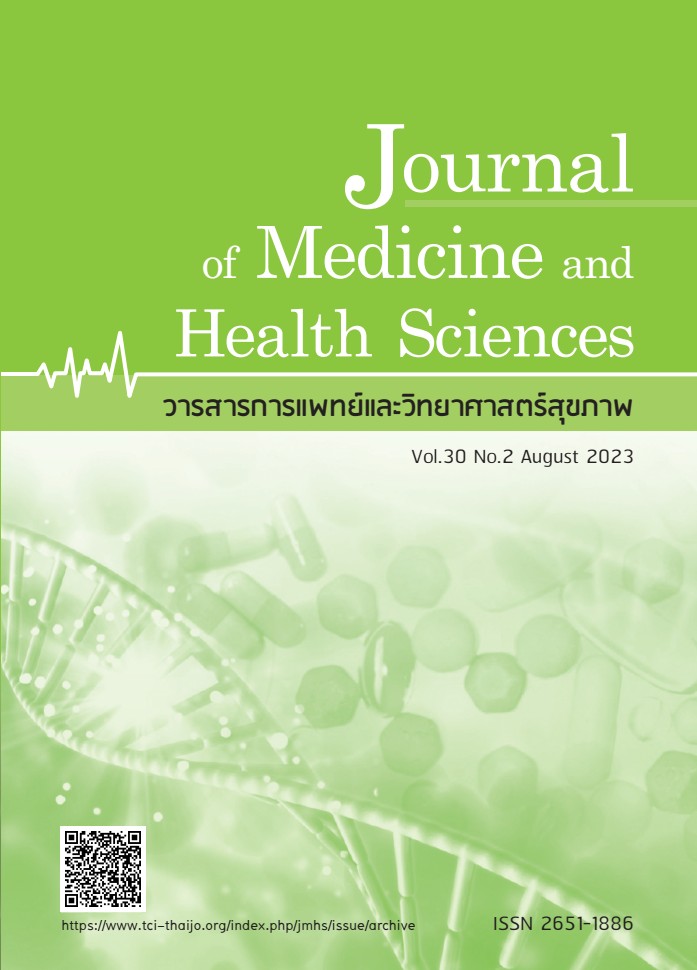Effect of intermittent pneumatic compression prophylaxis of venous thromboembolism in hip and knee surgery
Keywords:
intermittent pneumatic compression, venous thromboembolism, prophylaxisAbstract
Venous thromboembolism (VTE) is a serious problem in orthopedic surgery, especially hip and knee surgery. It was shown in recent study that VTE has a high mortality rate1. Standard VTE prophylaxis were chemical and mechanical, but were still concerned about bleeding during and after surgery. This caused a lack of proper chemical use. The benefit of mechanical prophylaxis alone is still questioned. However, the intermittent pneumatic compression device (IPC) is another choice for VTE mechanical prophylaxis. Moreover, this study covered incidence, demographic data, underlying disease and the length of hospital stay between two groups. The retrospective cohort study was processed in Samutprakarn General Hospital from 1st January 2021 to 31st December 2022. All of the data were collected from medical records and the human research ethics was issued by a government agency. Then, purposive sampling was applied with an inclusion and exclusion criteria and was classified into two groups, the first group used a new VTE prophylaxis protocol with an IPC device and the second group used a standard VTE prophylaxis protocol. The statistical analysis employed descriptive statistics and invariable analysis with Pearson’s Chi-Square and Fisher’s Exact test, and multivariable analysis with an independent t-test. Duplex Doppler ultrasonography in DVT or CT-angiography in PE was used for confirmation diagnosis. After analysis, the results showed that the VTE incidence in the new VTE prophylaxis protocol group (0.67%) was lower than standard VTE prophylaxis protocol (5.70%) with a statistical difference. The demographic data, underlying disease, and length of hospital stay had no statistical difference (p>0.05). In contrast, for body mass index (BMI), the experimental group was higher than the control group (p<0.05). In conclusion, the new VTE prophylaxis protocol can decrease incidence of VTE at a lower level than the standard group.
References
William L, Craig J, Richard L, et al. Complications of total knee arthroplasty: standardized list and definitions of the Knee Society. Clin Orthop Relat Res 2013;471:215-20.
Della CJ, Steiger DJ, Di Cesare PE. Thromboembolism after hip and knee arthroplasty: diagnosis and treatment. J Am Acad Orthop Surg 1998;6:327-36.
McKenna R, Bachmann F, Kaushal SP, et al. Thromboembolic disease in patients undergoing total knee replacement. J Bone Joint Surg Am 1976;58:928-32.
Stringer MD, Steadman CA, Hedges AR, et al. Deep vein thrombosis after elective knee surgery. An incidence study in 312 patients. J Bone Joint Surg Br 1989;71:492-7.
Schindler OS, Dalziel R. Post-thrombotic syndrome after total hip or knee arthroplasty: Incidence in patients with asymptomatic deep venous thrombosis. J Orthop Surg 2005;13:113-9.
Haake DA, Berkman SA. Venous thromboembolic disease after hip surgery. Risk factors, prophylaxis, and diagnosis. Clin Orthop Relat Res 1989:212-31.
Stulberg BN, Insall JN, Williams GW, et al. Deep-vein thrombosis following total knee replacement. An analysis of six hundred and thirty-eight arthroplasties. J Bone Joint Surg AM 1984;66:194-201.
Pongsnroj D, Waewwanjit D, Nimitpan P, et al. Impact of implementation of clinical nursing practice guidelines in prevention
ofvenous thromboembolism on multiple traumatic injury patients’ Incidence of venous thromboembolism, length of
hospitalization, and medical expenses. JTNMC 2022;37:46-60.
Saengdidtha B. World thrombosis day. RTA Med J 2014;67:171-4.
Wu T, Tang LV, Hu Y. Venous thromboembolism in kidney diseases and genetic predisposition. Kidney Dis 2022;8:181-9.
Hotoleanu C, Andercou A. Risk factors in venous thromboembolism in hospitalized patients. Cent Eur J Med 2014;9:729-35.
Kovindha A, Kammuang-lue P. Pulmonary embolism after manual muscle testing in an incomplete paraplegic patient: a case
report. Spinal Cord 2014;52:S6-7.
Finan RR, Tamim H, Ameen G, et al. Prevalence of factor V G1691A (factor V-Leiden) and prothrombin G20210A gene mutations in a recurrent miscarriage population. Am J Hematol 2002;71:300-5.
Phamornpon S. The role of nurses in promoting early postoperative ambulation. TRC Nurs J 2016;9:15-23.
Kanchanabat B, Stapanavatr W, Meknavin S, et al. Systematic review and meta-analysis on the rate of postoperative venous thromboembolism in orthopaedic surgery in Asian patients without thromboprophylaxis. Br J Surg 2011;98:1356-64.
Jacobs JJ, Mont MA, Bozic KJ, et al. American academy of orthopedics surgeons clinical practice guideline on: preventing venous thromboembolic disease in patients undergoing elective hip and knee arthroplasty. J Bone Joint Surg Am 2012;94:746-7.
Wells PS, Anderson DR, Rodger M, et al. Derivation of a simple clinical model to categorize patients probability of pulmonary embolism: increasing the models utility with the SimpliRED D-dimer. Thromb Haemost 2000;83:416-20.
Downloads
Published
How to Cite
Issue
Section
License

This work is licensed under a Creative Commons Attribution-NonCommercial-NoDerivatives 4.0 International License.



